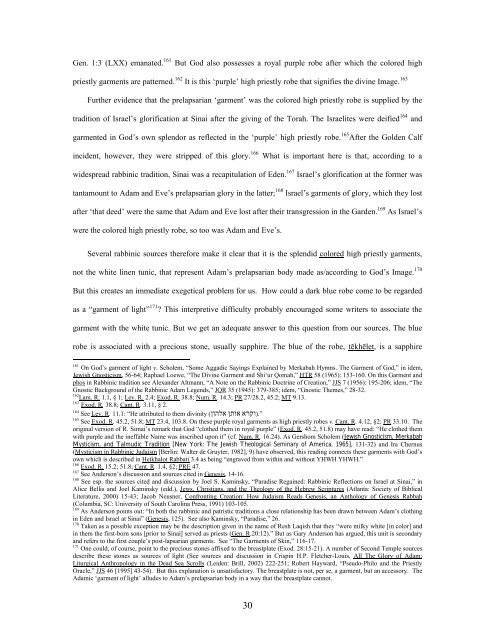Sapphiric God: - Dr. Wesley Muhammad
Sapphiric God: - Dr. Wesley Muhammad
Sapphiric God: - Dr. Wesley Muhammad
You also want an ePaper? Increase the reach of your titles
YUMPU automatically turns print PDFs into web optimized ePapers that Google loves.
Gen. 1:3 (LXX) emanated. 161 But <strong>God</strong> also possesses a royal purple robe after which the colored high<br />
priestly garments are patterned. 162 It is this ‘purple’ high priestly robe that signifies the divine Image. 163<br />
Further evidence that the prelapsarian ‘garment’ was the colored high priestly robe is supplied by the<br />
tradition of Israel’s glorification at Sinai after the giving of the Torah. The Israelites were deified 164 and<br />
garmented in <strong>God</strong>’s own splendor as reflected in the ‘purple’ high priestly robe. 165 After the Golden Calf<br />
incident, however, they were stripped of this glory. 166 What is important here is that, according to a<br />
widespread rabbinic tradition, Sinai was a recapitulation of Eden. 167 Israel’s glorification at the former was<br />
tantamount to Adam and Eve’s prelapsarian glory in the latter; 168 Israel’s garments of glory, which they lost<br />
after ‘that deed’ were the same that Adam and Eve lost after their transgression in the Garden. 169 As Israel’s<br />
were the colored high priestly robe, so too was Adam and Eve’s.<br />
Several rabbinic sources therefore make it clear that it is the splendid colored high priestly garments,<br />
not the white linen tunic, that represent Adam’s prelapsarian body made as/according to <strong>God</strong>’s Image. 170<br />
But this creates an immediate exegetical problem for us. How could a dark blue robe come to be regarded<br />
as a “garment of light” 171 ? This interpretive difficulty probably encouraged some writers to associate the<br />
garment with the white tunic. But we get an adequate answer to this question from our sources. The blue<br />
robe is associated with a precious stone, usually sapphire. The blue of the robe, tĕkhēlet, is a sapphire<br />
161<br />
On <strong>God</strong>’s garment of light v. Scholem, “Some Aggadic Sayings Explained by Merkabah Hymns. The Garment of <strong>God</strong>,” in idem,<br />
Jewish Gnosticism, 56-64; Raphael Loewe, “The Divine Garment and Shi‘ur Qomah,” HTR 58 (1965): 153-160. On this Garment and<br />
phos in Rabbinic tradition see Alexander Altmann, “A Note on the Rabbinic Doctrine of Creation,” JJS 7 (1956): 195-206; idem, “The<br />
Gnostic Background of the Rabbinic Adam Legends,” JQR 35 (1945): 379-385; idem, “Gnostic Themes,” 28-32.<br />
162<br />
Lam. R. 1.1, § 1; Lev. R. 2.4; Exod. R. 38.8; Num. R. 14.3; PR 27/28.2, 45.2; MT 9.13.<br />
163<br />
Exod. R. 38.8; Cant. R. 3.11, § 2.<br />
164<br />
See Lev. R. 11.1: “He attributed to them divinity (ןוהלא ןתוא ארקו).”<br />
165<br />
See Exod. R. 45.2, 51.8; MT 23.4, 103.8. On these purple royal garments as high priestly robes v. Cant. R. 4.12, §2; PR 33.10. The<br />
original version of R. Simai’s remark that <strong>God</strong> “clothed them in royal purple” (Exod. R. 45.2, 51.8) may have read: “He clothed them<br />
with purple and the ineffable Name was inscribed upon it” (cf. Num. R. 16.24). As Gershom Scholem (Jewish Gnosticism, Merkabah<br />
Mysticism, and Talmudic Tradition [New York: The Jewish Theological Seminary of America, 1965], 131-32) and Ira Chernus<br />
(Mysticism in Rabbinic Judaism [Berlin: Walter de Gruyter, 1982], 9) have observed, this reading connects these garments with <strong>God</strong>’s<br />
own which is described in Heikhalot Rabbati 3.4 as being “engraved from within and without YHWH YHWH.”<br />
166<br />
Exod. R. 15.2; 51.8; Cant. R. 1.4, §2; PRE 47.<br />
167<br />
See Anderson’s discussion and sources cited in Genesis, 14-16.<br />
168<br />
See esp. the sources cited and discussion by Joel S. Kaminsky, “Paradise Regained: Rabbinic Reflections on Israel at Sinai,” in<br />
Alice Bellis and Joel Kaminsky (edd.), Jews, Christians, and the Theology of the Hebrew Scriptures (Atlanta: Society of Biblical<br />
Literature, 2000) 15-43; Jacob Neusner, Confronting Creation: How Judaism Reads Genesis, an Anthology of Genesis Rabbah<br />
(Columbia, SC: University of South Carolina Press, 1991) 103-105.<br />
169<br />
As Anderson points out: “In both the rabbinic and patristic traditions a close relationship has been drawn between Adam’s clothing<br />
in Eden and Israel at Sinai” (Genesis, 125). See also Kaminsky, “Paradise,” 26.<br />
170<br />
Taken as a possible exception may be the description given in the name of Resh Laqish that they “were milky white [in color] and<br />
in them the first-born sons [prior to Sinai] served as priests (Gen. R.20:12).” But as Gary Anderson has argued, this unit is secondary<br />
and refers to the first couple’s post-lapsarian garments. See “The Garments of Skin,” 116-17.<br />
171<br />
One could, of course, point to the precious stones affixed to the breastplate (Exod. 28:15-21). A number of Second Temple sources<br />
describe these stones as sources of light (See sources and discussion in Crispin H.P. Fletcher-Louis, All The Glory of Adam:<br />
Liturgical Anthropology in the Dead Sea Scrolls (Leiden: Brill, 2002) 222-251; Robert Hayward, “Pseudo-Philo and the Priestly<br />
Oracle,” JJS 46 [1995] 43-54). But this explanation is unsatisfactory. The breastplate is not, per se, a garment, but an accessory. The<br />
Adamic ‘garment of light’ alludes to Adam’s prelapsarian body in a way that the breastplate cannot.<br />
30
















